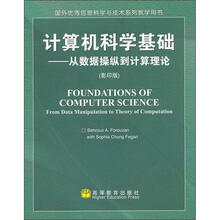计算机科学基础:从数据操纵到计算理论

目 录内容简介
PART I COMPUTER AND DATA 1
Chapter 1 Introduction 2
1.1 The Computer as a Black Box
1.2 von Neumann Model
1.3 Computer Hardware
1.4 Data
1.5 Computer Software
1.6 History
1.7 Key Terms
1.8 Summary
1.9 Practice Set
Chapter 2 Data Representation
2.1 ata Types
2.2 Data inside the Computer
2.3 Representing data
2.4 Hexadecimal Notation
2.5 Octal Notation
2.6 Key Terms
2.7 Summary
2.8 Practice Set
Chapter 3 Number Representation
3.1 Desimal and Binary
3.2 Conversion
3.3 Lnteger Representation
3.4 Excess System
3.5 Floating-Representation
3.6 Hexadecimal Notation
3.7 Key Terms
3.8 Summary
3.9 Practice Set
Chapter 4 Operations On Bits
4.1 Arithmetic Operations
4.2 Logical Operations
4.3 Shift Operations
4.4 Key Terms
4.5 Summary
4.6 Practice Set
PART II COMPUTER HARDWARE
Chapter 5 Computer Organization
5.1 Central Processing Unit(CPU)
5.2 Main Memory
5.3 Input/Output
5.4 Subsystem Interconnection
5.5 Program Execution
5.6 Two Different Architectures
5.7 Key Terms
5.8 Summary
5.9 Practice Set
Chapter 6 Computer Networks
6.1 Networks,Large and Small
6.2 OSI Model
6.3 Categoies of Networks
6.4 Connecting Devices
6.5 The Internet and TCP/IP
6.6 Key Terms
6.7 SUmmary
6.8 practice Set
PART III COMPUTER SOFTWARE
Chapter 7 Operating Systems
7.1 Definition
7.2 Evolution
7.3 Compunents
7.4 Popular Operating Systens
7.5 Key Terms
7.6 SUmmary
7.7 Practice Set
Chapter 8 Algorithms
8.1 Concept
8.2 Three Constructs
8.3 Algorithm Representation
8.4 More Formal Definition
8.5 Subalgorithms
8.6 Basic Algorithms
8.7 Recursion
8.8 Key Terms
8.9 Summary
8.10 Practice Set
Chapter 9 Programming Languages
9.1 Evolution
9.2 Building a Program
9.3 Program Execution
9.4 Categories of Languages
9.5 A Procedural :anguage:C
9.6 Key Terms
9.7 Summary
9.8 Practice Set
Chapter 10 Software Engineering
10.1 Software Life Cycle
10.2 Development Process Models
10.3 Modularity
10.4 Quality
10.5 Documentation
10.6 Key Terms
10.7 Summary
10.8 Practice Set
PART IV DATA ORGANIZATION
Chapter 11 Data Structures
11.1 Arrays
11.2 Resords
11.3 Linked Lists
11.4 Key Terms
11.5 Summary
11.6 Practice Set
Chapter 12 Abstract Data Types
12.1 Background
12.2 Linear Lists
12.3 Stacks
12.4 Queues
12.5 Trees
12.6 Binary Trees
12.7 Graphs
12.8 Key Terms
12.9 Summary
12.10 Practice Set
Chapter 13 File Structuers
13.1 Acdess Methods
13.2 Sequential Files
13.3 Indexed Files
13.4 Hashed Files
13.5 Text versus Binary
13.6 Key Terms
13.7 Summary
13.8 Practice Set
Chapter 14 Databases
14.1 Database Management System
14.2 Auchitecture
14.3 Database Models
14.4 Relatioang Model
14.5 Operations Relations
14.6 Structured Query Language
14.7 Other Database Models
14.8 Key Terms
14.9 Summary
14.10 Practice Set
PART V ADVANCED TOPICS
Chapter 15 Data Compression
15.1 Lossless Compression
15.2 Lossy Compression Methods
15.3 Key Terms
15.4 Summary
15.5 Practice Set
Chapter 16 Security
16.1 Privacy
16.2 Digital Signature
16.3 Key Terms
16.4 Summary
16.5 Practice Set
Chapter 17 Theory Computation
17.1 Simple Languge
17.2 turing Machine
17.3 Godel Numbers
17.4 Halting Problem
17.5 Solvable and Unsolvable Problems
17.6 Key Terms
17.7 Summary
17.8 practic Set
Chapter 1 Introduction 2
1.1 The Computer as a Black Box
1.2 von Neumann Model
1.3 Computer Hardware
1.4 Data
1.5 Computer Software
1.6 History
1.7 Key Terms
1.8 Summary
1.9 Practice Set
Chapter 2 Data Representation
2.1 ata Types
2.2 Data inside the Computer
2.3 Representing data
2.4 Hexadecimal Notation
2.5 Octal Notation
2.6 Key Terms
2.7 Summary
2.8 Practice Set
Chapter 3 Number Representation
3.1 Desimal and Binary
3.2 Conversion
3.3 Lnteger Representation
3.4 Excess System
3.5 Floating-Representation
3.6 Hexadecimal Notation
3.7 Key Terms
3.8 Summary
3.9 Practice Set
Chapter 4 Operations On Bits
4.1 Arithmetic Operations
4.2 Logical Operations
4.3 Shift Operations
4.4 Key Terms
4.5 Summary
4.6 Practice Set
PART II COMPUTER HARDWARE
Chapter 5 Computer Organization
5.1 Central Processing Unit(CPU)
5.2 Main Memory
5.3 Input/Output
5.4 Subsystem Interconnection
5.5 Program Execution
5.6 Two Different Architectures
5.7 Key Terms
5.8 Summary
5.9 Practice Set
Chapter 6 Computer Networks
6.1 Networks,Large and Small
6.2 OSI Model
6.3 Categoies of Networks
6.4 Connecting Devices
6.5 The Internet and TCP/IP
6.6 Key Terms
6.7 SUmmary
6.8 practice Set
PART III COMPUTER SOFTWARE
Chapter 7 Operating Systems
7.1 Definition
7.2 Evolution
7.3 Compunents
7.4 Popular Operating Systens
7.5 Key Terms
7.6 SUmmary
7.7 Practice Set
Chapter 8 Algorithms
8.1 Concept
8.2 Three Constructs
8.3 Algorithm Representation
8.4 More Formal Definition
8.5 Subalgorithms
8.6 Basic Algorithms
8.7 Recursion
8.8 Key Terms
8.9 Summary
8.10 Practice Set
Chapter 9 Programming Languages
9.1 Evolution
9.2 Building a Program
9.3 Program Execution
9.4 Categories of Languages
9.5 A Procedural :anguage:C
9.6 Key Terms
9.7 Summary
9.8 Practice Set
Chapter 10 Software Engineering
10.1 Software Life Cycle
10.2 Development Process Models
10.3 Modularity
10.4 Quality
10.5 Documentation
10.6 Key Terms
10.7 Summary
10.8 Practice Set
PART IV DATA ORGANIZATION
Chapter 11 Data Structures
11.1 Arrays
11.2 Resords
11.3 Linked Lists
11.4 Key Terms
11.5 Summary
11.6 Practice Set
Chapter 12 Abstract Data Types
12.1 Background
12.2 Linear Lists
12.3 Stacks
12.4 Queues
12.5 Trees
12.6 Binary Trees
12.7 Graphs
12.8 Key Terms
12.9 Summary
12.10 Practice Set
Chapter 13 File Structuers
13.1 Acdess Methods
13.2 Sequential Files
13.3 Indexed Files
13.4 Hashed Files
13.5 Text versus Binary
13.6 Key Terms
13.7 Summary
13.8 Practice Set
Chapter 14 Databases
14.1 Database Management System
14.2 Auchitecture
14.3 Database Models
14.4 Relatioang Model
14.5 Operations Relations
14.6 Structured Query Language
14.7 Other Database Models
14.8 Key Terms
14.9 Summary
14.10 Practice Set
PART V ADVANCED TOPICS
Chapter 15 Data Compression
15.1 Lossless Compression
15.2 Lossy Compression Methods
15.3 Key Terms
15.4 Summary
15.5 Practice Set
Chapter 16 Security
16.1 Privacy
16.2 Digital Signature
16.3 Key Terms
16.4 Summary
16.5 Practice Set
Chapter 17 Theory Computation
17.1 Simple Languge
17.2 turing Machine
17.3 Godel Numbers
17.4 Halting Problem
17.5 Solvable and Unsolvable Problems
17.6 Key Terms
17.7 Summary
17.8 practic Set
目 录内容简介
进入21世纪,尤其随着我国加入WTO信息产业的国际竞争将更加激烈。我国信息产业虽然在20世纪末取得了迅猛发展,但与发达国家相比,甚至与印度、爱尔兰等国家相比,还有很大的差距。国家信息化的发展速度和信息产业的国际竞争能力,最终都将取决于信息科学技术人才的质量和数量。引进国外信息科学和技术优秀教材,在有条件的学校推动开展英语授课或双语教学,是教育部为加块培养大批高质量的信息技术人才采取的一项重要举措。
比价列表
公众号、微信群
 缺书网
缺书网微信公众号
 扫码进群
扫码进群实时获取购书优惠





